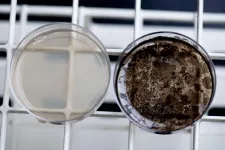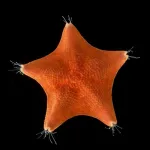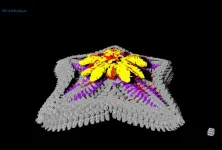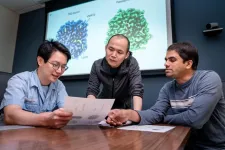(Press-News.org) Exploring Arctic nature can be difficult. Harsh conditions and great distances are significant challenges when researchers want to coax secrets out of nature.
However, a research project, led by Greenlandic and Danish researchers, has now succeeded in describing a new type of ringed seal that lives in the Icefjord near Ilulissat in West Greenland; a unique natural area on the UNESCO World Heritage List.
The results have just been published in the renowned scientific journal Molecular Ecology.
A small population
Over a number of years, the researchers together with local hunters captured seals in nets and mounted a small satellite transmitter on the seals’ backs. When the seals were up for air, the satellite transmitter sent a message about their location.
”We could see that the Kangia seals primarily stay inside the Icefjord. We were able to count the seals from a plane and therefore able to estimate that there are only approx. 3,000 of these special Kangia ringed seals,” says Aqqalu Rosing-Asvid, Senior Researcher at the Pinngortitaleriffik – Greenland Institute of Nature, and one of the researchers behind the study.
The small resident population is highly unusual compared to the typical Arctic ringed seal, which has an enormous population size and often travels thousands of kilometres around the Arctic in search of food.
Isolated for thousands of years
The researchers also took small tissue samples from the captured seals. The samples were sent for genetic analyses to uncover the seals’ DNA profile, and the results revealed that the Kangia ringed seals are genetically different from the typical Arctic ringed seal.
But where and how the Kangia ringed seal was isolated from the other Arctic ringed seals and why it acquired its new special biological characteristics is still a mystery.
Perhaps also special seals in other Arctic fjords
The study emphasises that there is still much we do not know about the diversity of organisms in the Arctic and thus their possibilities to adapt to climate change and human activities.
“There are many other fjords in the Arctic that have not yet been studied in detail, and where the ringed seals may also have locally developed new genetic variants,” points out Rune Dietz, Professor at the Department of Ecoscience at Aarhus University, who also participated in the study.
END
The ringed seals in Ilulissat Icefjord, Greenland are special
Local hunters in the Icefjord near Ilulissat have long known about a special ringed seal – the Kangia seal – which is significantly larger and has a markedly different fur colour and pattern than typical Arctic ringed seals. Now scientific studies hav
2023-11-01
ELSE PRESS RELEASES FROM THIS DATE:
NRL ISS Mission seeks new bioinspired materials
2023-11-01
WASHINGTON – The U.S. Naval Research Laboratory’s Melanized Microbes for Multiple Uses in Space Project, or MELSP, will use the International Space Station (ISS) to search for production of melanin variants and other useful biomaterials that can have applications both on Earth and in space. The mission is scheduled to launch in early November 2023.
Melanin is described as a group of biopolymers responsible for various biological functions, including pigmentation of skin, hair, and iris of the eyes, which helps protect body ...
Pinpointing HIV immune response
2023-11-01
New research combining computer modeling and experiments with macaques shows the body’s immune system helps control human immunodeficiency virus (HIV) infections largely by suppressing viral production in already infected cells while also killing viral infected cells, but only within a narrow time window at the start of a cell’s infection.
“To eliminate HIV, we have to understand how the immune system attempts to control the infection,” said Ruy M. Ribeiro, a theoretical biologist at Los Alamos National Laboratory who led the development of the model ...
First mice engineered to survive COVID-19 like young, healthy humans
2023-11-01
Researchers have genetically engineered the first mice that get a human-like form of COVID-19, according to a study published online November 1 in Nature.
Led by researchers from NYU Grossman School of Medicine, the new work created lab mice with human genetic material for ACE2 – a protein snagged by the pandemic virus so it can attach to human cells as part of the infection. The mice with this genetic change developed symptoms similar to young humans infected with the virus causing COVID-19, instead of dying ...
As people live longer, family caregivers face financial challenges
2023-11-01
PHILADELPHIA (November 1, 2023) – Many people overlook the short- and long-term costs of financial caregiving, a growing problem that financial advisors and employers can help address, according to a new report by the TIAA Institute and the University of Pennsylvania School of Nursing (Penn Nursing).
One in five adults now provide uncompensated care to loved ones with health problems, and the report provides a comprehensive compilation of insights and research that underscores how the caregivers face a ...
Human mini guts reveal new insights into the process leading to Cronkhite-Canada syndrome and potential new therapies
2023-11-01
Researchers at Baylor College of Medicine and collaborating institutions working with human intestinal organoids, also called mini guts, have shed new light on the potential causes of Cronkhite-Canada syndrome, a rare condition characterized by abundant non-cancerous growths or polyps in the intestine and other symptoms such as hair and nail loss and changes in skin pigmentation. Published in The Journal of Clinical Investigation, the study is the first to show a connection between high polyp proliferation and increased levels of serotonin produced by the intestinal epithelium.
The findings suggest a potential new approach to treat this disease with serotonin ...
Long presumed to have no heads at all, sea stars may be nothing but
2023-11-01
For centuries, naturalists have puzzled over what might constitute the head of a sea star, commonly called a “starfish.” When looking at a worm, or a fish, it’s clear which end is the head and which is the tail. But with their five identical arms — any of which can take the lead in propelling sea stars across the seabed — it’s been anybody’s guess how to determine the front end of the organism from the back. This unusual body plan has led many to conclude that sea stars perhaps don’t have a head at all.
But ...
Starfish body is a head, say scientists
2023-11-01
EMBARGOED: Not for Release Until 01 November 2023 at 16:00 (London time)
The bodies of starfish and other echinoderms are more like heads, according to new research involving the University of Southampton.
The research, published today [1 November] in Nature, helps to answer the mystery of how these creatures evolved their distinctive star-shaped body, which has long puzzled scientists.
Echinoderms are a group of animals that includes starfish (or sea stars), sea urchins, and sand dollars. They have a unique ‘fivefold symmetric’ body plan, which means ...
Scientists reveal structures of neurotransmitter transporter
2023-11-01
(Memphis, Tenn – November 1, 2023) Neurons talk to each other using chemical signals called neurotransmitters. Scientists at St. Jude Children’s Research Hospital have drawn on structural biology expertise to determine structures of vesicular monoamine transporter 2 (VMAT2), a key component of neuronal communication. By visualizing VMAT2 in different states, scientists now better understand how it functions and how the different shapes the protein takes influence drug binding — critical information for ...
Heterogeneity of Earth’s mantle may be relics of Moon formation
2023-11-01
An interdisciplinary international research team has recently discovered that a massive anomaly deep within the Earth’s interior may be a remnant of the collision about 4.5 billion years ago that formed the Moon.
This research offers important new insights not only into Earth’s internal structure but also its long-term evolution and the formation of the inner solar system.
The study, which relied on computational fluid dynamics methods pioneered by Prof. DENG Hongping of the Shanghai Astronomical Observatory (SHAO) of ...
Study reveals location of starfish’s head
2023-11-01
If you put a hat on a starfish, where would you put it? On the center of the starfish? Or on the point of an arm and, if so, which one? The question is silly, but it gets at serious questions in the fields of zoology and developmental biology that have perplexed veteran scientists and schoolchildren in introductory biology classes alike: Where is the head on a starfish? And how does their body layout relate to ours?
Now, a new Stanford study that used genetic and molecular tools to map out the body regions of starfish – by creating a 3D atlas of their gene ...
LAST 30 PRESS RELEASES:
Bluey’s dad offered professorial chair in archaeology at Griffith University
Beyond small data limitations: Transfer learning-enabled framework for predicting mechanical properties of aluminum matrix composites
Unveiling non-thermal catalytic origin of direct current-promoted catalysis for energy-efficient transformation of greenhouse gases to valuable chemicals
Chronic breathlessness emerging as a hidden strain on hospitals
Paleontologists find first fossil bee nests made inside fossil bones
These fossils were the perfect home for ancient baby bees
Not everyone reads the room the same. A new study examines why.
New research identifies linked energy, immune and vascular changes in ME/CFS
Concurrent frailty + depression likely boost dementia risk in older people
Living in substandard housing linked to kids’ missed schooling and poor grades
Little awareness of medical + psychological complexities of steroid cream withdrawal
Eight in 10 trusts caring for emergency department patients in corridors, finds BMJ investigation
NASA’s Webb telescope finds bizarre atmosphere on a lemon-shaped exoplanet
The gut bacteria that put the brakes on weight gain in mice
Exploring how patients feel about AI transcription
Category ‘6’ tropical cyclone hot spots are growing
Video: Drivers struggle to multitask when using dashboard touch screens, study finds
SLU research shows surge in alcohol-related liver disease driving ‘deaths of despair’
Rising heat reshapes how microbes break down microplastics, new review finds
Roots reveal a hidden carbon pathway in maize plants
Membrane magic: FAMU-FSU researchers repurpose fuel cells membranes for new applications
UN Member States pledge to increase access to diagnosis and inhaled medicines for the 480 million people living with COPD
Combination therapy shows potential to treat pediatric brain cancer ATRT
Study links seabird nesting to shark turf wars in Hawai‘i
Legal sports betting linked to sharp increases in violent crime, study finds
Breakthrough AI from NYUAD speeds up discovery of life-supporting microbes
New Eva Mayr-Stihl Foundation funding initiative boosts research at University of Freiburg on adaptation of forests to global change
The perfect plastic? Plant-based, fully saltwater degradable, zero microplastics
Bias in data may be blocking AI’s potential to combat antibiotic resistance
Article-level metrics would provide more recognition to most researchers than journal-level metrics
[Press-News.org] The ringed seals in Ilulissat Icefjord, Greenland are specialLocal hunters in the Icefjord near Ilulissat have long known about a special ringed seal – the Kangia seal – which is significantly larger and has a markedly different fur colour and pattern than typical Arctic ringed seals. Now scientific studies hav





